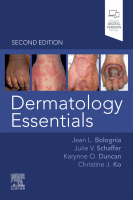Physical Address
304 North Cardinal St.
Dorchester Center, MA 02124

Scabies Infestation by Sarcoptes scabiei var . hominis , a mite that lives within the stratum corneum of human skin ( Fig. 71.1 ). Transmission is primarily by direct contact with an infested person and occasionally by fomites (e.g. clothing);…

Leishmaniasis Three major forms: (1) cutaneous ( Fig. 70.1 ); (2) mucocutaneous ( Fig. 70.2 ); and (3) visceral (e.g. liver, spleen). Caused by more than 15 different species of Leishmania ( Table 70.1 ). Table 70.1 Four major species…

In this chapter, five sexually transmitted infections (STIs) are covered – syphilis, gonorrhea, chancroid, lymphogranuloma venereum (LGV), and granuloma inguinale. Additional more common STIs including herpes simplex infections, mollusca contagiosa, condyloma acuminata, pubic lice, and HIV infection are discussed in…

Viral infections frequently have cutaneous manifestations, especially in children. This chapter covers classic childhood exanthems, poxvirus infections, and several other viral infections with characteristic skin findings. Nonspecific viral exanthems , typically presenting with blanchable erythematous macules and papules in a…

General Human herpesviruses (HHV) are a family of double-stranded DNA viruses (8 members) with a lipid envelope. All share the ability to establish lifelong latency in their host following primary infection. Basic pathogenesis of HHV infections involves a sequence of…

Key Points Human papilloma viruses (HPV) comprise a large group of at least 200 genotypes of DNA viruses that infect the skin and mucosa. Different genotypes cause different skin lesions ( Table 66.1 ). – Clinical variants differ as to…

There are a number of cutaneous disorders that point to the diagnosis of HIV infection. For some, it is the mere presence of the skin disease, whereas for others, the disease is extensive or proves recalcitrant to therapy ( Table…

Key Points Cutaneous fungal diseases can be broadly divided into two groups: – Superficial – limited to the stratum corneum, hair, and/or nails – Deep – dermal and/or subcutaneous Superficial fungal infections can be further subdivided into: – Non-inflammatory –…

Rickettsial infections often have cutaneous manifestations that can vary from nonspecific maculopapular eruptions to an eschar at the site of inoculation (by the vector) to petechiae and retiform purpura ( Table 63.1 ). These Gram-negative bacteria reside within an arthropod…

Key Points Mycobacteria are the etiologic agents of three major types of infection: – Leprosy – Mycobacterium leprae – Tuberculosis – Mycobacterium tuberculosis – Atypical or nontuberculous infections – e.g. Mycobacterium marinum, Mycobacterium chelonae ( Tables 62.1 and 62.2 )…